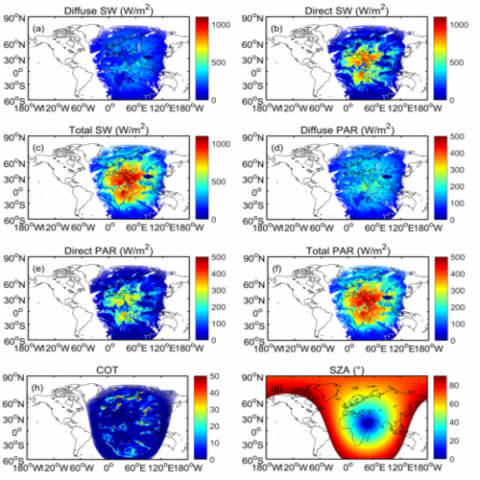The direct and diffused components of downward shortwave radiation (SW), and photosynthetically active radiation (PAR) at the Earth surface play an essential role in biochemical (e.g. photosynthesis) and physical (e.g. energy balance) processes that control weather and climate conditions, and ecological processes. Space-based observations have the unique advantage of providing reliable estimates of SW and PAR globally with sufficient accuracy for constructing Earth’s radiation budget and estimating land-surface fluxes that control these processes. However, most existing space-based SW and PAR estimations from sensors onboard polar-orbiting and geostationary satellites have inherently low temporal resolution and/or limited spatial coverage of the entire Earth surface. The unique location/orbit of Earth Polychromatic Imaging Camera (EPIC) onboard the Deep Space Climate Observatory (DSCOVR) provides an unprecedented opportunity to obtain global estimates of SW and PAR accurately at a high temporal resolution of about 1~2 hour. In this study, we developed and used a model (random forest, RF) to estimate global hourly SW and PAR at 10-km spatial resolution based on EPIC measurements. We used a combination of EPIC Level-2 products, including solar zenith angle, aerosol optical depth, cloud optical thickness, cloud fraction, total column ozone and surface pressure with their associated quality flags to drive the RF model for estimating SW and PAR. We evaluated the model results against in situ observations from the Baseline Surface Radiation Network (BSRN) and Surface Radiation Budget Network (SURFRAD). We found the EPIC SW and PAR estimates at both hourly and daily time scales to be highly correlated and consistent with these independently obtained in situ measurements. The RMSEs for estimated daily diffuse SW, direct SW, total SW, and total PAR were 19.10, 38.47, 33.52, and 14.09 W/m239 , respectively, and the biases for these estimates were 1.71, -0.77, 1.04 and 4.11 W/m240 , respectively. We further compared the estimated SW and PAR with the Clouds and the Earth’s Radiant Energy System Synoptic 1 ×1 (CERES SYN1deg) products and found a good correlation and consistency in their accuracy, spatial patterns and latitudinal gradient. The EPIC SW and PAR estimates provide a unique dataset (i.e. observations from single instrument from pole to-pole for the entire sunlit portion of Earth) for characterizing their diurnal cycles and their potential impact on photosynthesis and evapotranspiration processes.
Projects (1)
Category
Datasets
54

